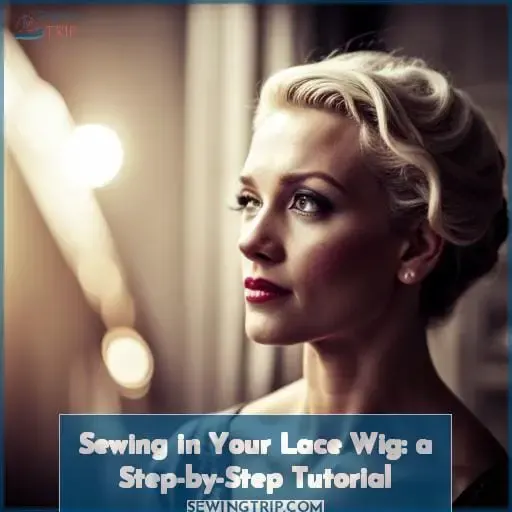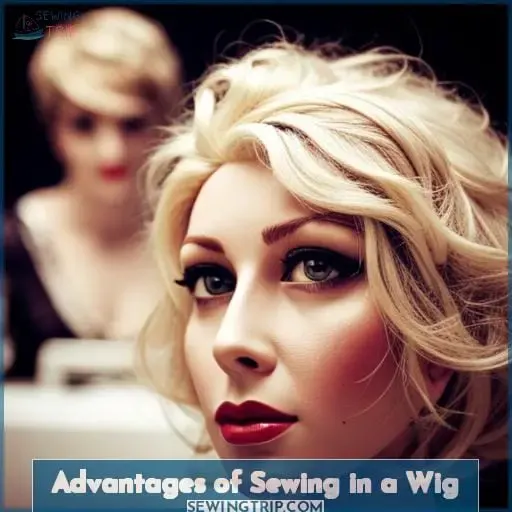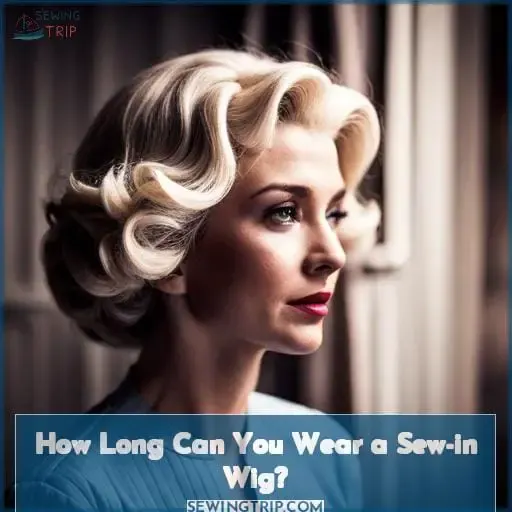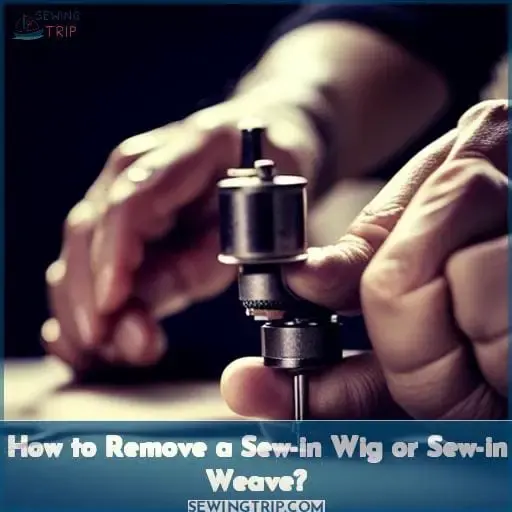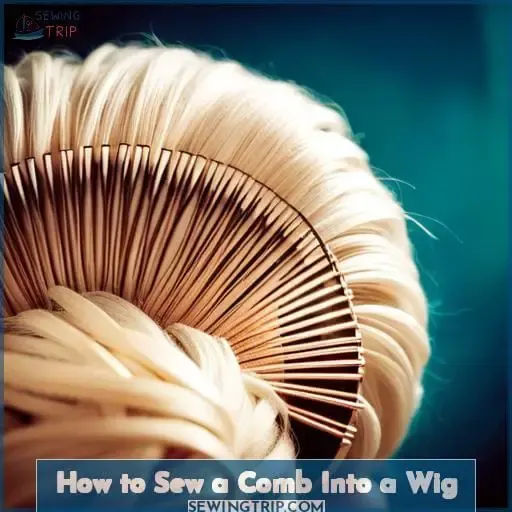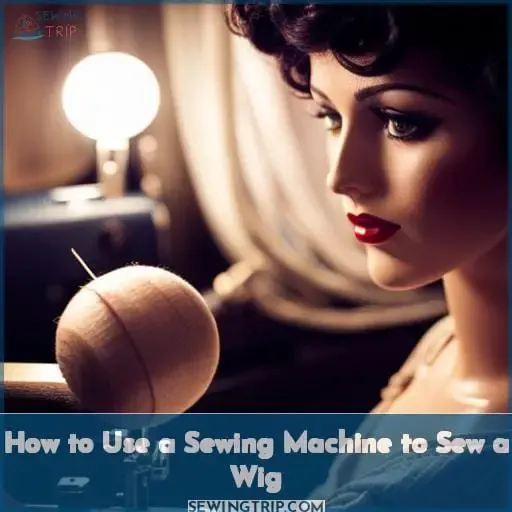This site is supported by our readers. We may earn a commission, at no cost to you, if you purchase through links.
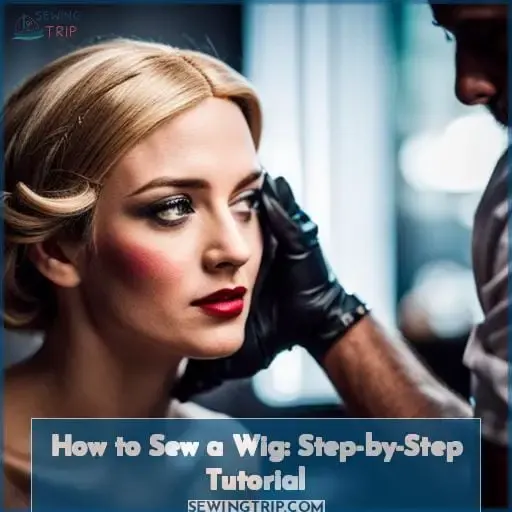 Imagine having the power to create your own custom wig, perfectly suited to your style and preferences. With this step-by-step tutorial on how to sew a wig, you’ll learn the secrets of professional cosmetologists and hair stylists.
Imagine having the power to create your own custom wig, perfectly suited to your style and preferences. With this step-by-step tutorial on how to sew a wig, you’ll learn the secrets of professional cosmetologists and hair stylists.
From preparing your natural hair to securing the wig with expert stitching techniques, you’ll master every aspect of creating a flawless look.
Table Of Contents
- Key Takeaways
- Sewing in Your Lace Wig: a Step-by-Step Tutorial
- Advantages of Sewing in a Wig
- How Long Can You Wear a Sew-in Wig?
- How to Take Care of a Sew-in Wig or Sew-in Weave?
- How to Remove a Sew-in Wig or Sew-in Weave?
- How to Sew Clips Into a Wig
- How to Sew a Comb Into a Wig
- How to Use a Sewing Machine to Sew a Wig
- Frequently Asked Questions (FAQs)
- Conclusion
Key Takeaways
- Secure the natural hair tightly before attaching the wig, using techniques like braiding and bobby pins.
- Customize the wig for an ideal fit by trimming excess lace and aligning it to the natural hairline.
- Use small, 1/2 inch stitches close together when sewing on the wig for stability.
- Properly store and gently maintain the wig between wearings to preserve quality.
Sewing in Your Lace Wig: a Step-by-Step Tutorial
Now it’s time to dive into the process of sewing in your lace wig.
First, you’ll need to prepare your natural hair by choosing a braiding style and ensuring all hair is tightly braided.
Next, carefully place the wig on your head, aligning it for a secure fit.
Then comes the adjusting and trimming stage where you’ll trim excess lace and sew seams behind ears and over the top of your head.
Finally, secure the wig with stitches about ½ apart for a strong attachment and maintain its beauty through regular washing and detangling routines.
Preparing Your Natural Hair
Before you begin sewing in your lace wig, tightly braid and secure your natural hair with bobby pins. This ensures a smooth foundation for the wig placement, trimming techniques, and secure sewing process.
Placing the Wig on Your Head
To begin sewing in your lace wig, start by:
- Positioning the wig on your head using clips to secure it in place.
- Adjusting the fit and aligning the hairline for a natural look.
Before proceeding with attaching the wig securely.
Adjusting and Trimming the Wig
Adjust the wig to ensure a perfect fit by trimming and adjusting it according to your natural hairline and desired style.
Use precise trimming techniques for:
- Wig customization
- Lace front alignment
- Stylish hairline adjustments during the sew-in process.
Securing the Wig With Sewing
Next, sew the wig in place to ensure a secure attachment.
Use advanced stitching techniques and unique attachments like sewing clips into the wig or sewing combs for added security.
This step is crucial for customizing styles and achieving a perfect fit.
Maintaining and Caring for the Wig
Now that you have successfully sewn in your lace wig, it’s important to know how to properly maintain and care for it.
-
Wig Hygiene:
- Keep your wig clean by washing it every 10 days or after sweating.
- Use a mild shampoo and conditioner specifically designed for wigs.
-
Storage Tips:
- When not wearing the wig, store it on a Styrofoam head or in a satin-lined box to preserve its shape and prevent tangling.
-
Wig Styling:
- Style the wig as desired using heat styling tools on human hair wigs only; synthetic wigs can’t withstand heat styling without damage.
Note – Be sure to brush the front left side of the wig gently with a large bristle brush before storing or wearing again.
Advantages of Sewing in a Wig
When it comes to sewing in a wig, there are several advantages that make this method worth considering.
One of the main benefits is that it provides a long-lasting and secure attachment, ensuring that the wig stays in place even during active movements.
Additionally, sewing in a wig gives you a natural appearance and feel since there’s no need for adhesives or glues.
Lastly, maintaining sewn-in wigs requires minimal effort compared to other methods, making them convenient for those with busy lifestyles.
Long-lasting and Secure Attachment
When sewing in a wig, you can enjoy the advantages of long-lasting and secure attachment by following these steps.
Use precision sewing techniques to ensure longevity and scalp health.
The versatility of wigs allows for various styles, while comfort tips like using a styrofoam wig head enhance the overall experience.
Natural Appearance and Feel
One of the advantages of sewing in a wig is that it provides a natural appearance and feel to your hair.
By creating texture and securing the wig with careful stitching, you can achieve a seamless blend between your own hair and the wig.
Sewing clips into specific areas, like the front right side using a banana clip, adds extra security for an even more natural look.
No Need for Adhesives
One advantage of sewing in a wig is that you don’t need to use adhesives.
The custom fit created by sewing ensures a secure attachment without the hassle of glues or tapes.
This method also allows for:
- Easy lace application
- Maintenance tips
- Versatile styling options
- Temporary solutions.
Minimal Maintenance Required
With sewing in a wig, you can enjoy the advantages of minimal maintenance.
Once properly sewn in, your wig will require less upkeep compared to other attachment methods. This means fewer styling sessions and more time for you to focus on rocking different looks or taking care of your scalp health.
Additionally, the removal process is much easier and gentler on both your natural hair and the wig itself, ensuring a longer lifespan for your favorite accessory.
How Long Can You Wear a Sew-in Wig?
As a licensed cosmetologist or hair stylist, you understand the importance of knowing how long a sew-in wig can be worn.
- The quality of the wig
- Proper care and maintenance
- Individual preferences
It’s crucial to educate your clients about these factors so they can make informed decisions about when it’s time to remove and reinstall their sew-in wigs for optimal results.
Duration of Wear
How long can you comfortably wear a sew-in wig?
The duration of wear depends on various factors, but with proper care and maintenance, you can enjoy continuous wear for several weeks.
- Follow proper care instructions for washing and conditioning the wig.
- Avoid excessive heat styling to prevent damage to the hair fibers.
- Regularly remove the wig for scalp cleansing and give your natural hair a break from constant tension.
Proper Care and Maintenance
To ensure the longevity of your sew-in wig and maintain its quality, it’s important to properly care for and maintain it. This involves proper wig storage, hair hydration, using appropriate styling techniques, utilizing wig accessories, and maintaining scalp health.
Here are some tips to help you take care of your sew-in wig:
| Wig Storage | Hair Hydration |
|---|---|
| Store in a cool and dry place away from direct sunlight | Use leave-in conditioners or moisturizing sprays regularly |
| Avoid storing near heat sources like heaters or radiators | Deep condition the hair every few weeks |
| Styling Techniques | Wig Accessories |
|---|---|
| Avoid excessive heat styling as it can damage the hair | Use satin caps or scarves to protect the edges while sleeping |
| Opt for low manipulation styles such as braids or buns | Invest in a good quality wig stand for proper display when not being worn |
| Scalp Health |
|---|
| Keep your scalp clean by washing regularly with a gentle shampoo |
| Massage your scalp gently with oil treatments to promote circulation |
Signs It’s Time to Remove and Reinstall
If you notice any of these signs, it’s time to remove and reinstall your sew-in wig.
Signs that indicate it’s time for reinstallation include:
- Excessive shedding
- Matting or tangling of the hair
- A noticeable change in texture or appearance
- An uncomfortable fit causing scalp irritation or pain
- If the wig starts to lift off your natural hairline
Proper timing is crucial for maintaining the longevity and overall health of both your natural hair and the sew-in wig.
How to Take Care of a Sew-in Wig or Sew-in Weave?
To keep your sew-in wig or weave looking its best, there are a few important care tips to follow:
First and foremost, make sure to comb and brush your hair regularly to prevent tangles and maintain its appearance.
Additionally, avoid sleeping with the weaves in as this can cause damage over time.
Lastly, keeping your scalp clean and washing the wig according to the manufacturer’s directions will help prolong its lifespan and ensure it stays fresh-looking for longer periods of time.
Comb and Brush Regularly
Regularly comb and brush your sew-in wig or weave to prevent tangling.
- Use a wide-tooth comb, starting from the ends and working up.
- Brush in sections to thoroughly detangle.
- Avoid harsh brushing or combing to prevent damage.
- Apply leave-in conditioner to lubricate and ease detangling.
- Finger detangle any small, stubborn tangles.
Avoid Sleeping With Weaves
The next key thing you’ll want to do when caring for your sew-in is avoid sleeping with it.
Sleeping with weaves can cause tangling and damage to both the weave and your natural hair.
Invest in a satin bonnet or pillowcase to provide a smooth surface that reduces friction, preventing tangles while you sleep.
Keep Your Hair and Scalp Clean
To keep your hair and scalp clean while wearing a sew-in wig or weave, maintain a regular cleansing routine.
Start by selecting the right products for your hair type.
Wash your hair with gentle shampoos and conditioners, focusing on the scalp to remove dirt and buildup.
Follow up with hydrating treatments to keep your hair moisturized and prevent dryness.
Don’t forget to cleanse regularly for optimal scalp hygiene.
Wash According to Directions
When washing your sew-in according to the directions, you’re properly maintaining the wig or weave.
- Use cool or lukewarm water
- Apply wig-safe shampoo
- Rinse thoroughly
- Air dry on a wig stand
How to Remove a Sew-in Wig or Sew-in Weave?
When it’s time to take out your sewn-in wig, preparation is key for protecting your natural hair.
Carefully snip each stitch and unravel the threads, then use a wide-tooth comb to gently detangle the wig hair from your braids.
Proper storage in a breathable container after thoroughly cleaning the wig will allow you to reuse the hairpiece again down the road.
Preparing for Removal
Before unraveling your stitches, comb through your hair to remove any knots or tangles. This step is crucial in preparing the edge of your sew-in wig for removal. Take care not to pull too hard and damage the wig or your natural hair.
Unraveling the Sewing Stitches
How do you unravel sewing stitches?
Work methodically, using small, precise scissors or seam rippers to clip each thread.
Gently pull to release the tension slowly, while protecting edges.
Manage loose threads and secure hair sections during removal.
Adjust around sensitive areas deliberately.
Detangling and Cleaning
To detangle and clean your sew-in wig or weave, start by gently combing through the hair with a wide-toothed comb. This will help prevent breakage while removing any knots or tangles from the strands.
Detangling Techniques:
- Apply a leave-in conditioner: This will provide moisture that helps loosen knots and makes it easier to glide through stubborn tangles.
2.Use gentle finger-combing: Starting at the ends of the hair, use your fingers in downward motions to slowly work out any snarls without causing damage.
3.Utilize wider tooth combs: When necessary, switch from using just your fingers to incorporating wide-toothed combs into this process as they’re better suited for dealing with larger areas of tangled strands.
Cleaning Methods:
1.Washing Strategies – First wetting down then applying shampoo evenly throughout before rinsing off completely; ensuring no remnants remain behind which could cause build-up over time leading towards deteriorating quality within both appearance & longevity factors
2.Brushing Tips-Brush in one direction only (from roots towards ends) avoiding harsh movements such as pulling forcefully on individual hairs during brushing sessions
3.Maintenance Tricks-Regularly wash every 10 days after sweating heavily since oils can accumulate faster than anticipated thus needing extra care given their unique needs compared against other types found among natural hairstyles
Proper Storage
After removing a sew-in wig or sew-in weave, properly store it to maintain its quality and prolong its lifespan.
- Carefully brush out any tangles.
- Place the wig in a designated container or on a styrofoam head to preserve its shape.
- Regularly clean and style the wig for optimal hygiene and longevity.
How to Sew Clips Into a Wig
Now that you have your wig ready, it’s time to sew clips into it for a secure and comfortable fit.
Start by choosing the right clips that match the color of your wig and are sturdy enough to hold it in place.
Next, position the clips on strategic areas of the wig where they’ll provide maximum support.
Finally, carefully sew each clip onto the wig using a strong thread or weave thread to ensure they stay securely in place during wear.
Choosing the Right Clips
When sewing clips into a wig, you’ll want durable, comfortable clips that blend with the wig’s fibers.
Choosing the right clips is crucial for ensuring hair integration and secure attachment of your wig.
Look for high-quality metal or plastic clips that are designed specifically for wigs.
Consider clip size, grip strength, and ease of use to ensure a comfortable fit without causing any scalp irritation or discomfort.
Prioritize both wig security and scalp protection when selecting your clips.
Positioning and Marking Clip Placement
You position and mark the intended clip placements on the inside of the wig cap.
To ensure a secure attachment and proper alignment, follow these positioning techniques for clip placement:
- Begin by placing the wig on a styrofoam wig head to mimic your natural head shape.
- Use a flexible measuring tape or ruler to measure and mark precise locations for each clip.
- Take into account areas where you want extra support or where clips may be hidden under hair layers.
- Use a marker or sharpie to make clear, visible marks on the inside of the cap.
By marking with precision, you can confidently sew in your clips at their designated positions for optimal security when wearing your wig.
Sewing the Clips Onto the Wig
To sew clips onto the wig, start by positioning and marking where you want the clips to be placed.
Use a variety of clip sizes and types depending on your preferences. Choose from snap or toupee clips, ensuring they’re sturdy enough to securely hold the wig in place.
Sew each clip onto the designated area using strong sewing techniques for long-lasting attachment. This customization method allows for easy maintenance and ensures your hairpiece stays secure throughout wear.
| Sewing Techniques | Clip Varieties | Attachment Methods |
|---|---|---|
| Overcast Stitch | Snap Clips | Hand-sewn |
| Whipstitch | Toupee Clips | Machine-sewn |
How to Sew a Comb Into a Wig
Next, we’ll review some key steps for sewing a comb into your wig.
To do this properly, you’ll need to:
- Choose the right comb
- Figure out the best placement
- Stitch it securely onto the wig cap.
Selecting the Appropriate Comb
Any sturdy wig comb can be sewn in, but metal combs with thinner teeth work best for a secure attachment.
Consider the size of the comb to ensure it fits appropriately on your wig and provides proper support.
When selecting a material, opt for durable options like metal or hard plastic that can withstand regular use.
Properly attaching the comb involves sewing it onto the inside of the wig cap at strategic points to prevent movement during wear.
Comfort considerations include choosing a comb that won’t cause discomfort or irritation on your scalp and ensuring it doesn’t pull or tug at your hair while wearing the wig.
Additionally, selecting a well-designed comb will provide styling benefits by allowing you to easily create various hairstyles without worrying about slippage or instability.
Determining Comb Placement
The comb should be positioned at the nape of the wig for a secure fit.
When determining comb placement, consider balance and comfort. Find the right spot that ensures both stability and style.
Take into account your styling preferences and how you want to wear your wig. Make sure it feels comfortable on your head without causing any tension or discomfort.
Proper comb placement is crucial for maintaining security throughout wear.
Sewing the Comb Onto the Wig
Start by positioning and marking the placement of the comb on your wig.
Next, thread your needle and tie a knot at the end of the thread.
Bring the needle up through the base of the wig, then down through one hole in the comb.
Continue sewing in and out of the comb holes to attach it securely.
Check that the comb lays flat and makes good contact with the wig for stability.
Trim any excess thread once finished sewing.
Now your wig has an attachment comb for a customizable, secure fit.
How to Use a Sewing Machine to Sew a Wig
Now that you have prepared your wig and sewing machine, it’s time to dive into the process of using a sewing machine to sew a wig. This method offers precision and efficiency, ensuring a secure and professional result.
By following these steps, you’ll be able to seamlessly sew your wig with ease while achieving beautiful results in no time at all.
-
Prepare your wig.
- Cut the wig cap to size.
- Pin the wig cap to your head.
- Sew the wig cap to your head.
-
Thread your sewing machine.
- Choose a thread that matches the color of your wig.
- Thread the needle and bobbin.
-
Sew the wig.
- Start by sewing a few stitches along the front hairline of the wig.
- Continue sewing around the wig, making sure to keep the stitches close together.
- Sew a few stitches along the back of the wig.
-
Finish the wig.
- Trim any excess thread.
- Remove the pins from the wig cap.
- Put the wig on your head and enjoy!
Preparing the Wig and Machine
To prepare the wig and your sewing machine for the process of sewing a wig, gather all materials needed.
Ensure that your sewing machine is set up properly with the correct needle and thread.
Custom fit the wig on a styrofoam head to ensure proper measurements.
This will help in achieving stitch precision and maintaining wig security during wear.
Don’t forget to follow maintenance tips for long-lasting results!
Sewing the Wig With a Machine
Installation requires you’re threading the machine with wig hair instead of fabric.
Carefully feed the hair pieces under the presser foot to avoid tangles.
Adjust tension so the thread catches just a few hairs in each stitch.
Zigzag stitches work well securing tracks to lace caps.
For added hold, try a straight stitch near the wig’s edge.
Play with stitch length and thread weight until the wig feels secure.
Finishing and Cleaning Up
Now that you have finished sewing the wig with a machine, it’s time to focus on finishing touches and cleaning up.
- Use gentle cleaning techniques to remove any dirt or debris from the wig.
- Pay attention to polishing details and refining any imperfections.
- Create a maintenance routine to keep the wig looking fresh and beautiful.
- Add final touches like styling or trimming if desired for ultimate perfection.
Frequently Asked Questions (FAQs)
What kind of thread should I use to sew in my wig?
For sewing in your wig, I recommend using a strong and durable weave thread. This will ensure a secure attachment and longevity.
Choose a high-quality thread that matches the color of your wig for seamless blending.
How do I hide the knots after sewing in my wig?
After sewing in your wig, use a concealer that matches your scalp color to carefully dab over the knots.
Voila! Your knots are hidden and your wig looks natural.
What size needle works best for sewing wigs?
Looking to sew a wig on your head?
Wondering what size needle is best for the job?
Well, let me tell you, a jumbo cane weaving needle combo pack will do the trick!
Should I sew my wig while wearing it or off my head?
To achieve a secure and flawless wig installation, it’s recommended to sew the wig while it’s off your head.
How often should I replace the thread used to sew in my wig?
To maintain a secure attachment, it’s recommended to replace the thread used to sew in your wig every 4-6 weeks.
Conclusion
To achieve a flawless and personalized look, mastering the art of sewing a wig on your head is essential.
This step-by-step tutorial has guided you through the process, from preparing your natural hair to securing the wig with expert stitching techniques.
By sewing in your wig, you’ll enjoy long-lasting and secure attachment, a natural appearance, and minimal maintenance.
Whether you’re a licensed cosmetologist, a fashion designer, or simply a beauty enthusiast, this empowering journey of creating your custom wig is sure to elevate your style.

